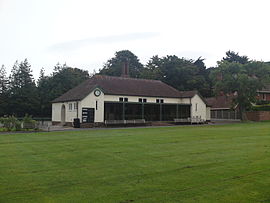|
Rydal Penrhos
Rydal Penrhos School is a private day school in Colwyn Bay, North Wales. It is the only Methodist school in the independent sector in Wales.[1] It is located on multiple sites around the town with a site in the neighbouring village of Rhos-on-Sea where it keeps its watersports equipment for easy access to the beach. HistoryThe school started life as five separate institutions:
In 1887, Payne founded St John's Methodist Church on Pwllycrochan Avenue, which was used regularly by both Rydal and Penrhos.[2] In 2010, the stewardship of St John's was passed to Rydal Penrhos, which needed more space for school worship and special events. In 2020 it was announced that the school would no longer offer a boarding option from 2021 and would operate as a day school only.[3] ArchitectureA degree of uniformity of design in central Colwyn Bay owes much to a single architect, Sidney Colwyn Foulkes, whose concept has been followed by other architects. His father designed St John's Methodist Church, and he was responsible for many of the school's buildings, as well as others in the vicinity, and further afield in North Wales. This led to the area that includes the school being designated as Colwyn Bay's first conservation area. Evacuation of Rydal SchoolDuring the Second World War, the main campus of Rydal was occupied by the Ministry of Food. The school was evacuated to Oakwood Park, a small country estate 2 miles west of the town of Conwy. The school returned to Colwyn Bay in 1946. Evacuation of Penrhos CollegeDuring the Second World War, the Penrhos College site was taken over by the government for Ministry of Food use. The Duke of Devonshire, anticipating that schoolgirls would make better tenants than soldiers, offered Chatsworth House for the use of the school. The contents of the house were packed away in eleven days and 300 girls and their teachers moved in for a six-year stay. The whole of the house was used, including the state rooms, which were turned into dormitories. Condensation from the breath of the sleeping girls caused fungus to grow behind some of the pictures. The house was not very comfortable for so many people, with a shortage of hot water, but there were compensations, such as skating on the Canal Pond. The girls grew vegetables in the garden as a contribution to the war effort. AmalgamationRydal Preparatory School merged with Penrhos Junior School in 1995 to become Rydal Penrhos Preparatory School, which, in 2003, underwent a further merger with Lyndon School, which retained its name until 2010. The former Penrhos Junior and Lyndon campuses were disposed of and staff and students were relocated to the larger existing Rydal Preparatory School campus. In 1999, Rydal School and Penrhos College agreed to merge as Rydal Penrhos School. Initially they were run as three separate divisions: "preparatory", "girls" and "co-educational", reflecting the three formerly separate incarnations. The Penrhos College campus was eventually closed down and sold for redevelopment, and its pupils moved to the main Rydal campus, the divisions being amalgamated into a single entity. The merger and integration was not without controversy, not least over the sale of the former Penrhos site and the restructuring of the staff. Introduction of the International BaccalaureateIn 2004, the school began to offer the International Baccalaureate programme of study in its sixth form years, as a parallel alternative to the A-level programme that was already being offered. This led to an increase in the number of pupils attending the school from overseas countries such as Ukraine, Belgium, Canada, Germany, France, Kenya, Nigeria, Peru, Russia and the Czech Republic. The school stopped teaching the International Baccalaureate programme when it ceased to offer boarding, and currently offers A-levels and Cambridge Technical courses to its sixth-form students.[4] First-class cricket
The school's cricket pitch was used as the venue for a first-class match between Wales and the touring South Africans in 1929.[5] The three-day match, played on 10–12 June 1929, resulted in a 10-run victory for the South Africans and saw Bob Catterall of South Africa (117) and William Bates of Wales (102) record centuries.[6] Denbighshire later played a single Minor Counties Championship match against Northumberland at the ground in 1934.[7] Notable alumni
References
External links
|
||||||||||||||||||||||||||||||||||||||||||||||||||||||||||||||||


